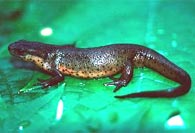
 Lose an arm? Grow it back! Newts have the ability to regenerate limbs, eyes and spinal cords. The cells at the site of the injury have the ability to de-differentiate, reproduce rapidly, and differentiate again to create a new limb or organ. One theory is that the de-differentiated cells are related to tumour cells since chemicals which produce tumours in other animals will produce additional limbs in newts. Lose an arm? Grow it back! Newts have the ability to regenerate limbs, eyes and spinal cords. The cells at the site of the injury have the ability to de-differentiate, reproduce rapidly, and differentiate again to create a new limb or organ. One theory is that the de-differentiated cells are related to tumour cells since chemicals which produce tumours in other animals will produce additional limbs in newts.
Toxic Skin: Many newts produce toxins in their skin secretions as a defence mechanism against predators. The Taricha newts of western North America are particularly toxic; the  Rough-skinned Newt (Taricha granulosa) of the Pacific Northwest produces more than enough tetrodotoxin to kill an adult human foolish enough to swallow a newt. Note that in order to produce harm, the toxins have to enter the body by being ingested or entering a break in the skin; it is safe to handle newts provided one thoroughly washes ones hands before eating. Rough-skinned Newt (Taricha granulosa) of the Pacific Northwest produces more than enough tetrodotoxin to kill an adult human foolish enough to swallow a newt. Note that in order to produce harm, the toxins have to enter the body by being ingested or entering a break in the skin; it is safe to handle newts provided one thoroughly washes ones hands before eating.
 Toxic - humans! Theoretically it is safe to handle newts provided one thoroughly washes one's hands. However, human skin is toxic to newts. Toxic - humans! Theoretically it is safe to handle newts provided one thoroughly washes one's hands. However, human skin is toxic to newts.
  Metamorphosis: Newts can take several years to reach sexual maturity. It is known that their main breeding season is between February and June. They are hatched as tadpoles from eggs laid in ponds or slow-moving streams (see image below) and then undergo metamorphosis, during which time they commonly leave the water, only to return to the water to live out their adult lives. Metamorphosis: Newts can take several years to reach sexual maturity. It is known that their main breeding season is between February and June. They are hatched as tadpoles from eggs laid in ponds or slow-moving streams (see image below) and then undergo metamorphosis, during which time they commonly leave the water, only to return to the water to live out their adult lives.
The red phase on land: During the time right after metamorphosis, many North American Newt species go through a phase called the eft phase. Their skin turns a reddish color and the animal lives its life on land, almost never seen in the water. It is not until the eft reaches adulthood will it begin to live its life in a more aquatic fashion, during which time it may rarely venture onto land.
All text is available under the terms
of the GNU Free Documentation License
|